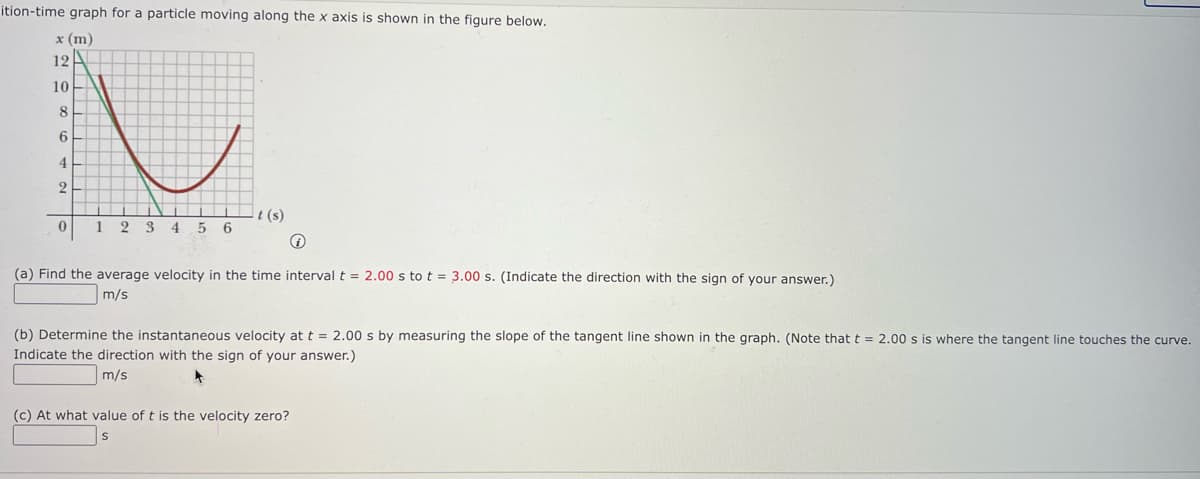ition-time graph for a particle moving along the x axis is shown in the figure below. x (m) 12A 10 8. 6. 4 2 t (s) 1 2 3 4 5 6 (a) Find the average velocity in the time interval t = 2.00 s to t = 3.00 s. (Indicate the direction with the sign of your answer.) m/s (b) Determine the instantaneous velocity at t = 2.00 s by measuring the slope of the tangent line shown in the graph. (Note that t = 2.00 s is where the tangent line touches the curve. Indicate the direction with the sign of your answer.) m/s (c) At what value of t is the velocity zero?
ition-time graph for a particle moving along the x axis is shown in the figure below. x (m) 12A 10 8. 6. 4 2 t (s) 1 2 3 4 5 6 (a) Find the average velocity in the time interval t = 2.00 s to t = 3.00 s. (Indicate the direction with the sign of your answer.) m/s (b) Determine the instantaneous velocity at t = 2.00 s by measuring the slope of the tangent line shown in the graph. (Note that t = 2.00 s is where the tangent line touches the curve. Indicate the direction with the sign of your answer.) m/s (c) At what value of t is the velocity zero?
Functions and Change: A Modeling Approach to College Algebra (MindTap Course List)
6th Edition
ISBN:9781337111348
Author:Bruce Crauder, Benny Evans, Alan Noell
Publisher:Bruce Crauder, Benny Evans, Alan Noell
Chapter5: A Survey Of Other Common Functions
Section5.4: Combining And Decomposing Functions
Problem 14E: Decay of Litter Litter such as leaves falls to the forest floor, where the action of insects and...
Related questions
Question

Transcribed Image Text:ition-time graph for a particle moving along the x axis is shown in the figure below.
x (m)
12A
10
8.
6
4
2
t (s)
1
2 3 4 5 6
(a) Find the average velocity in the time interval t = 2.00 s to t = 3.00 s. (Indicate the direction with the sign of your answer.)
m/s
(b) Determine the instantaneous velocity at t = 2.00 s by measuring the slope of the tangent line shown in the graph. (Note that t = 2.00 s is where the tangent line touches the curve.
Indicate the direction with the sign of your answer.)
m/s
(c) At what value of t is the velocity zero?
Expert Solution
This question has been solved!
Explore an expertly crafted, step-by-step solution for a thorough understanding of key concepts.
Step by step
Solved in 2 steps with 1 images

Recommended textbooks for you

Functions and Change: A Modeling Approach to Coll…
Algebra
ISBN:
9781337111348
Author:
Bruce Crauder, Benny Evans, Alan Noell
Publisher:
Cengage Learning

Functions and Change: A Modeling Approach to Coll…
Algebra
ISBN:
9781337111348
Author:
Bruce Crauder, Benny Evans, Alan Noell
Publisher:
Cengage Learning